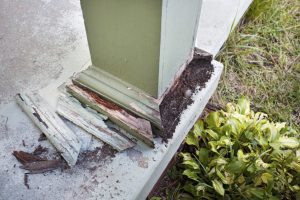
Termite infestations and how they affect your investment
While they might be small in size, Subterranean Termites are a large pest throughout Victoria. If steps aren’t taken to prevent termites, they can wreak havoc on wooden homes and other structures. To make matters worse, many insurance policies don’t cover costs incurred by termite infestation – and they’ve caused more damage to Australian homes than fires, floods and storms combined!
Your home and investment properties are some of the biggest investments you’ll ever make, if not the biggest, so protecting them is of the utmost importance.
One of the biggest problems a house can face is a pest infestation. Not only can a bad infestation potentially cause damage to your home or investment, but it can also bring in numerous illnesses and health problems that can affect you or your tenants.
Termites may bite and sting, but these wounds are not toxic. termites are not known to carry diseases harmful to humans. However, people who are living in homes infested by termites may suffer from allergic reactions or even asthma attacks. … Some people may even be allergic to termite saliva or droppings.
If you or your tenants have detected possible signs of an infestation, it is best to arrange an inspection as quickly as possible.
Items to be mindful of around your home or investment
Wood and cellulose material: Termites feed on lumber, firewood, newspapers and other cellulose materials. Do not store such materials near places that are easily accessible to termites, such as the foundation. Get rid of any decayed lumber or firewood, which termites prefer over sound wood.
Warm, dark places: Termites prefer moist, undisturbed places such as crawl spaces. Reduce moisture in your home’s crawl spaces by having your home inspected and evaluated for moisture sources and solutions.
Moist soil: Termites are attracted to moisture and there is usually plenty of moisture in the soil upon which your foundation is built. Keep the soil next to your home’s foundation as dry as possible by repairing any leaking faucets or pipes. Divert excess water from your foundation with properly functioning gutters, downspouts and splash blocks. Use lawn sprinklers and irrigation systems in a way that minimizes water accumulation near your foundation.
Tree stumps, stored lumber or firewood, cardboard boxes, untreated fence posts and buried scrap wood are all susceptible to a termite infestation. It is a good idea to inspect your home’s porches and other structural or foundation wood for signs of termites.
The most common signs of infestation include:
- Wood damage found below and behind surfaces like walls and floors. This includes cracks in the veneer or maze-like tunnelling in wood. Also, look for small holes in drywall or plaster walls that suggest termite activity.
- Discarded wings found near closed windows, doors and other entry points.
- Pencil-sized mud tubes found wherever the ground meets your home or near any other possible food sources, like trees or sheds.
How to help prevent a termite infestation
While houses do not attract termites actively, when termites find them, they are quick to come in. You’ll need to take measures to help keep an infestation from happening in your home. Usually, termite infestations are only spotted after they’ve become severe. Measures you can take to help prevent an infestation include replacing damaged wood and taking proper steps to correct the termite-attracting conditions listed above.
A more permanent solution to preventing termites involves the use of pesticides, which should be handled by a licensed pest control professional. If you suspect a termite invasion or are looking for ways to prevent one, its best to call someone with local knowledge and expertise.